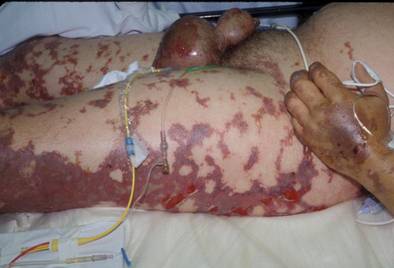Bacterial
Staphylococcal scalded skin syndrome (SSSS)
SSSS is a toxin-mediated disease characterized by erythema, widespread detachment of the superficial layers of the epidermis resembling scalding. It occurs mainly in newborns and infants less than two years.
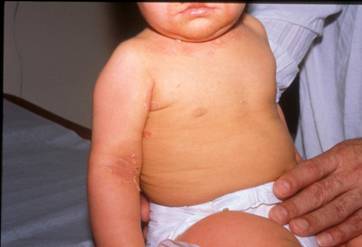
More Info: Staphylococcal scalded skin syndrome (SSSS)
Impetigo
Impetigo is a superficial infection of the epidermis by Staphylococcus aureus and Streptococcus pyogenes. Ecthyma is a little deeper than impetigo and the infection extends into the dermis. Both are characterized by crusted erosions or ulcerations. The infections may arise primarily in small breaks in the skin or as secondary infection on existing dermatitis. Some folks refer to this as "infantigo" which is not the correct term, but we think it's cute!
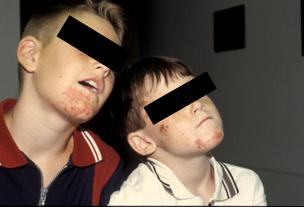
impetigo
Erysipelas and cellulitis
Erysipelas and cellulitis are acute, spreading infections of dermal and subcutaneous tissues, characterized by a red (rubor), hot (calor), and tender (dolor) area of skin often at the site of entry. Erysipelas is caused most frequently by beta-hemolytic streptococci. Cellulitis is more often due to staphylococcal has ill-defined borders, whereas the borders of erysipelas are more sharply demarcated.
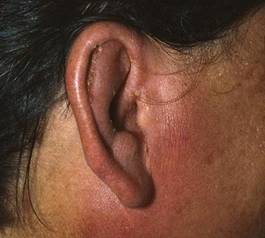
More Info: Erysipelas and cellulitis
Scarlet fever
Scarlet fever is an acute infection by group A Streptococcus. An exotoxin causes a diffusely erythematous sandpaper-like exanthem, referred to as a scarlitiniform eruption . It is named for its color; having nothing to do with "Gone with the Wind."
Meningococcal infection
Meningococcal infection is a life-threatening disorder which does not always, but may, manifest cutaneously as purpura fulminans. The bacterial agent is Neisseria meningitidis.
More Info: Meningococcal infection
Lyme disease
Lyme disease is characterized by erythema migrans, a local infection at the site of an Ixodes tick bite transmitting the spirochete Borrelia burgdorferiII. It begins as a macule or papule that enlarges within days to weeks to form an expanding annular lesion with a distinct red borders and partially clearing center. If untreated, the infection can hematogenously disseminate to many sites in the body. This is named for Lyme, Connecticut (though that is not the only place it is found) and has nothing to do with citrus fruit!
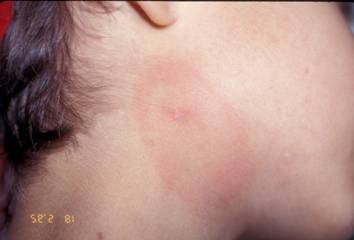
Rocky Mountain spotted fever
Rocky Mountain spotted fever is characterized by severe headache, fever, myalgia and a characteristic acral exanthem. Characteristically, a petechial rash begins on the wrists, forearms, and ankles and lastly on the palms and soles. The rash then spreads centripetally to the arms, thighs, trunk, and face in 6 to 18 hours. The causative agent is Rickettsia rickettsii which is transmitted via the wood tick Dermacentor andersoni.
